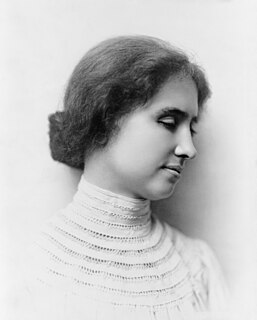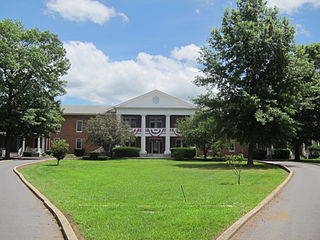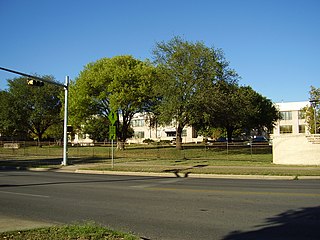Perkins School for the Blind, in Watertown, Massachusetts, was founded in 1829 and is the oldest school for the blind in the United States. It has also been known as the Perkins Institution for the Blind.

The Texas Department of Assistive and Rehabilitative Services (DARS) was a Texas state agency that was part of the Texas Health and Human Services Commission. The agency worked with Texans with disabilities and children with developmental delays to improve the quality of their lives and to enable their full participation in society.

Deafblindness is the condition of little or no useful hearing and little or no useful sight. Different degrees of vision loss and auditory loss occur within each individual, thus making the deafblind community unique with many types of deafblindness involved. Because of this inherent diversity, each deafblind individual's needs regarding lifestyle, communication, education, and work need to be addressed based on their degree of dual-modality deprivation, to improve their ability to live independently. In 1994, an estimated 35,000–40,000 United States residents were medically deafblind. Helen Keller was a well-known example of a deafblind individual. To further her lifelong mission to help the deafblind community to expand its horizons and gain opportunities, the Helen Keller National Center for Deaf-Blind Youths and Adults, with a residential training program in Sands Point, New York, was established in 1967 by an act of Congress.
The Royal Institute for Deaf and Blind Children (RIDBC) in Sydney provides a range of educational services for students with vision and/or hearing impairment, including specialist schools for signing Deaf students, oral deaf students, and students with sensory and intellectual disabilities.

The West Virginia Schools for the Deaf and the Blind (WVSDB) were established by an Act of the Legislature on March 3, 1870. The School for the Deaf and the School for the Blind offer comprehensive educational programs for hearing impaired and visually impaired students respectively. There is also a unit for deafblind and multihandicapped children. Students are eligible to enroll at the age of three, must be residents of the state of West Virginia and exhibit a hearing or visual loss sufficient to prevent normal progress in the usual public school setting. The West Virginia Schools for the Deaf and Blind are located on a campus in Romney in West Virginia's Eastern Panhandle. Locally, the schools are referred to simply as The state school.

The Texas School for the Blind and Visually Impaired (TSBVI) is a Texas special public school, in the continuum of statewide placements for students who have a visual impairment. It is considered a statewide resource to parents of these children and professionals who serve them. Students, ages 6 through 21, who are blind, deafblind, or visually impaired, including those with additional disabilities, are eligible for consideration for services at TSBVI.
Deaf Children Australia (DCA) is a national not-for-profit organisation that supports deaf and hard of hearing children and young people and their families in Australia.
CanDo4Kids is South Australia's oldest charity and works directly with children and young adults with sensory impairment disabilities, such as blindness and deafness, by focusing on what children "can do" and helping them to reach their full potential.

Francis Maginn (1861–1918) was a Church of Ireland missionary who worked to improve living standards for the deaf community by promoting sign language and was one of the co-founders of the British Deaf Association.

The Royal Association for Deaf people (RAD) is a British charitable organisation whose mission is to promote the welfare and interests of Deaf people. It is a Deaf-led organisation.
Kent Association for the Blind is a registered charity providing rehabilitation services for children and adults with visual impairment to support them and help them live independent lives. Services are provided by six, specialist rehabilitation teams based in offices in Kent, Medway and Bromley. Additional specialist support is provided in Bexley.
Linden Lodge School for the Blind is a specialist sensory and physical college located in Wimbledon, South London, England. It educates visually impaired children aged between two and nineteen, including those who are multi-disabled visually impaired.
Henshaws Society for Blind People, by Oldham businessman Thomas Henshaw, is a specialist charity providing support, advice and training to anyone affected by sight loss and other disabilities.
An intervener is a person who regularly works one-to-one with an individual who is deaf-blind. Deafblindness is a low incidence disability that describes individuals with varying degrees of vision and hearing losses. The combined loss often compromises the ability to access information in the environment or to communicate effectively. Interveners, by contributing communication and information, provide a medium through which deaf-blind individuals can link to the people, things and events in the world. Interveners provide services in educational settings for students, as well as in early intervention and community settings. The improvement of the social and emotional well-being of individuals with disabilities, is the goal of interveners.

St Thomas Syriac Orthodox Cathedral Acton is a Syriac Orthodox Cathedral in Acton, London, England, formerly known as St Saviour's Centre for the Deaf Anglican church, which was a social centre for deaf people, and the first and only purpose-built church for deaf people as such. St Saviour's was the central location for the London Diocesan Chaplaincy among Deaf and Deafblind people. The church and social centre closed in 2014 following a loss of funding, and insufficient financial reserves to maintain the premises. The final church service was held on Wednesday 24 September 2014, at which the Bishop of Willesden officiated.

Adaptive Physical Education (APE) is a physical education program that accommodates the needs of students with disabilities, that may include or be a combination of mobility or physical impairments, sensory impairments, intellectual disabilities, emotional or behavioural disorders. Physical education is important for the health and wellbeing of everyone, regardless of disabilities or not. APE programs are vital in maintaining and enhancing the quality of life for people with disabilities.

Geraldine Jerrie Lawhorn was a figure of the American deafblind community, a performer, actress, pianist, then instructor at the Hadley Institute for the Blind and Visually Impaired. At 67 years old, she became the first deafblind African American to earn a college degree in the United States of America.
Deafblind UK is a national charity in the United Kingdom supporting people with sight and hearing loss to live the lives they want. Founded in 1928, Deafblind UK has its headquarters in Peterborough, Cambridgeshire. The charity help people to live with deafblindness by making connections, and building their confidence and independence through a range of services and campaigns. Run by staff and volunteers, the current CEO is Steve Conway, who has been in position since 2018. The current chairman in Robert Nolan.
Vasile Adamescu was a Romanian educator. Deafblind from age two, Adamescu taught children with sensory deficiencies. He was awarded the Romanian National Order of Merit in 2013.
Protactile is a language used by deafblind people using tactile channels. Unlike other sign languages, which are heavily reliant on visual information, protactile is oriented towards touch and is practiced on the body. Protactile communication originated out of communications by deafblind people in Seattle in 2007 and incorporates signs from American Sign Language. Protactile is an emerging system of communication in the United States, with users relying on shared principles such as contact space, tactile imagery, and reciprocity.








